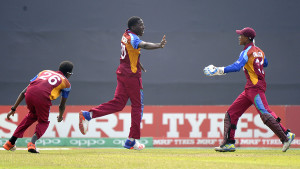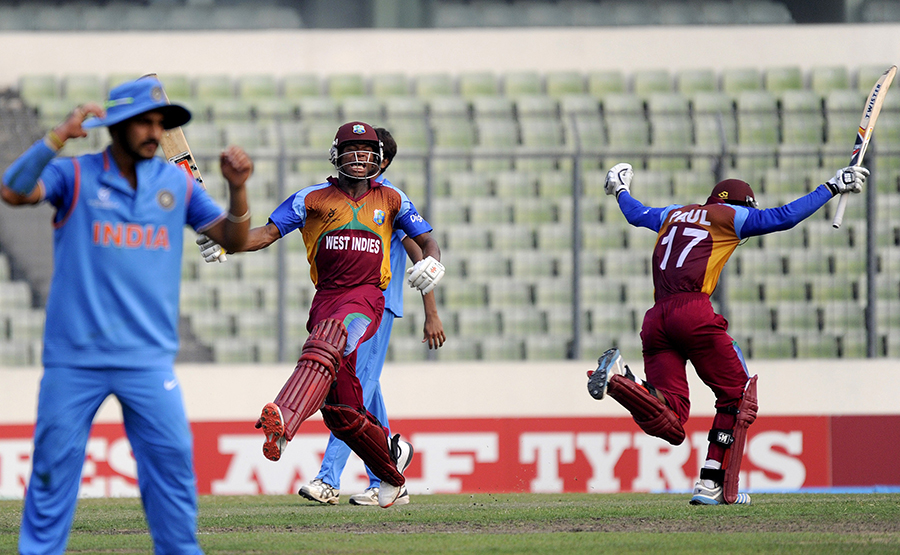Keacy Carty and Keemo Paul batted for 20.3 overs to wipe out the 69 remaining runs needed to win their first Under-19 World Cup title. There were pockets where an inevitable collapse looked a possibility, but the pair batted with the serenity and confidence that belied their age. Incredibly, Paul struck the only four and six in the partnership. Carty’s answer when asked if it was a conscious effort gave you a peek into his temperament.
“Singles could have done it. We just needed 146 from 300 balls,” he said.
Wait, that’s not how West Indies do it these days, do they?

Even as some of the other sides played practice matches in the build-up to the tournament, West Indies Under-19 players had to make do with conditioning camps © Getty Images
A careful, and not carefree approach, did the trick. Every run they took in the unbroken sixth-wicket stand indicated their willingness to grind it out and not look for glory hits. At no stage did they look nervous. They didn’t seem to mind the odd miss or the fact that they were made to scrap and look ungainly, particularly against Mayank Dagar, the left-arm spinner, who troubled them with his loop and flight.
What they also showed during the course of the partnership was the hunger to succeed and not leave the task up to someone else.
Equally impressive was their ability to think out of the box. Paul’s Mankad on Richard Ngarava that turned around their campaign andTevin Imlach’s underarm flick to catch Rishabh Pant off guard in the final were just a few examples. Watching them come out and play like free-spirited tigers, you could sense their changed mindset and approach.
The beauty of their win wasn’t in their preparation, but their execution at crunch moments. Unlike some of the other sides, West Indies played all of three matches together as a group against Bangladesh, who had played 29 matches between the two editions. Shimron Hetmyer’s side came into the tournament on the back of a 3-0 whitewash. They started slowly, but found their bearings when it mattered. That they managed to pull through as a side despite playing a handful of games together in the build-up could perhaps be put down to their Under-15 and Under-17 development structure, where a few of the side’s members played together.
In between 2014 and 2016, most of the players featured in the regional Under-19 tournament; handful of them played first-class or List A matches for their respective sides. To make up for the lack of cricket together as a group, the WICB organised three conditioning camps, the first of which was held in Barbados after the Easter holidays last year.
Then they got together a group of 18 in Jamaica in August, while the final touches of their preparation was added in Grenada in December. Interestingly, their late replacement, the fast bowler Chemar Holder, was not in any of these camps.
On the eve of the final, Hetmyer said that the team was hurt by the three losses to Bangladesh, but insisted all the players learnt a lot and tried to use their experience of the conditions better. “The guys were hurting after that series, but each and every member of the squad picked up from there.”
Former West Indies fast bowler Ian Bishop, who followed this team throughout the campaign as a TV commentator, said that he felt the Mankad incident spurred on the team. “I think the Zimbabwe win and the whole Mankad issue, whether you agree it was right or wrong, spurred them on,” he said. “Some of the issue that was said about Keemo Paul and team, was disgraceful. I don’t think it’s a coincidence, because they just lifted their game after that. The passage of cricket was untidy. I didn’t see the Fiji game, but they showed potential against England even if they lost.”
Bishop said while their preparation was far from ideal, the tournament was an indication that there was still plenty of talent underneath the surface in the Caribbean. “They didn’t have ideal preparation and it should not serve as the template going into the next World Cup,” he observed. “But what the win says is that there is tremendous amount of talent. We don’t have the volume of bowlers and batsmen in the past, but I think we have enough talent and these guys have proved that it needs to be harnessed.”
This coming together has been the long lost story of West Indies cricket. A group of teenagers have now shown the way, whether it is through sheer guts to effect a Mankad or run a batsman who was just leaving the ball and taking a step out. In the heat of the battle, their realization that Mohammad Saifuddin was only bowling yorkers and it can be tackled by a shorter back-lift and low intensity batting, said much about their awareness which should win a lot of praise.
The likes of Paul, Imlach and Shamar Springer now have full cricket careers. But they are from the West Indies; the conflicting West Indies, the dying West Indies. The West Indies that is only in nostalgia and one whose future seems uncertain.
When they win a World Cup in the sub-continent by beating Pakistan, Bangladesh and India in the knockout stages and do so the hard way, you wouldn’t want to give up on them so soon.
(Taken from ESPN Sports Media Ltd, by Mohammad Isam)


